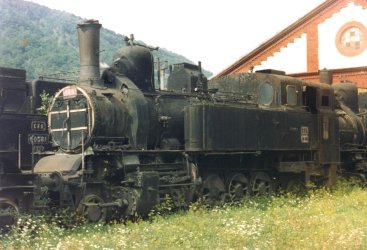Text Ing. JINDŘICH BEK
Photo JIiří MAURENZ
Published: Železničář 1981, č.14 |


Click to enlarge the picture |
The steam cog locomotives were manufactured in several factories
in Europe. One of them was the locomotive factory in Floridsdorf, which shipped
them mainly for the railways of former austrian monarchy. Well known were the
narrow-gauge (760 mm) engines C1' or C2' for railways in Bosnia. For the
standard gauge were series of types with modular design created, where the same
wheels, cylinders and others patrs were used. Between 1896 and 1900 four
locomotives D2' were manufactured for the railway Tisovec - Hronská Polhora, in
1902 3 locomotives D1' for the railway Tanwald - Kořenov and in 1911
six-wheelers series 269. Similarly, in 1908, for the railway Caransebes -
Subcetate (today Romaina) 7 locomotives 1'D1' were manufactured. All of them
have the same wheels, cylinders and with the exception of the 269 series the
same boiler.
The locomotives for the railway in Romania whith the rising up to 500/00
drove always at the front of train, that is why they had the Adams axis
both on front and back end and the water tank on the both sides of the boiler.
The exterior is very similar to Czechoslovakian 403.5 and 404.0. The next
difference was, that the second coupled wheel-pair is also the driving one.
The locomotive factory in Floridsdorf shipped in 1908 seven engines with the
factory numbers 1.782 až 1788. They have the inner frame and within it the
steam cog engine with two cog wheel-pairs. This engine has an extra regulator.
The adhesive steam engine is also the twin-cylinder and drives the adhesive
wheels independently of the cog ones. The locomotive has the power cca 441
- 514 kW.
From the all cog locomotions from Floridsdorf, these at CFR were last in the
service. They were changed by repairs, like decorative strip on chimney, other
cover of steam dome, but the principle could not be changed. The pressure break
was added, but all others breaks and the other details shows, how pretty were
the designers in Wien before 70 years, when the locomotion was built.
The Abt's cog locomotives were on the top not only from the point of view of the
construction, but also from the point of view of the servis security and
suitability. If you sometimes visit the Romania and ride the only romanian cog
railway, you agree, for sure.
Short remark to actual state: Nach 70 Betriebsjahren wurde die Strecke 1978 aufgegeben. Von den 7 Lokomotiven wurde nur eine, die 40.002 D in 1994 verschrottet nachdem sie in den ´80 als Dampfgenerator in Bw Barlad diente und 1989 noch in Pionierpark im Iasi zu sehen war. Die anderen Lokomotiven dieser Baureihe hatten mehr Glück. 40.001 D ist zu sehen in Bw Petrosani, 40.003 D und 40.007 D sind Zuhause in Bw Subcetate, 40.004 D in Lokomotiven Museum in Sibiu. Diese Lok war Ende des Zweiten Weltkrieges in Zagreb wegen Reparaturarbeiten und kam 1946 zurück nach Rumänien. 40.005 D und 40.006 D gehören Bw Subcetate.
(Source: http://www.lasting.ro/RailRoad/Html/40006neu.htm) 
40.006 D mit der Werksnummer 1786/1908 in Bw Subcetate in 1988
|